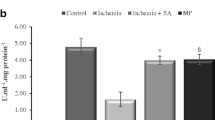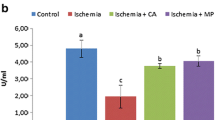Abstract
Purpose
We designed an experimental study to show the effects of some agents in order to prevent reperfusion injury of the spinal cord.
Methods
Twenty rabbits were used and were divided into two groups in our study. Infrarenal abdominal aortic occlusion, between renal arteries and iliac bifurcations, was applied to the subjects in group 1 for only 30 min; in the group 2 subjects, on the other hand, intra-aortic diltiazem, N-acetylcysteine, and catalase combinations were applied after infrarenal abdominal aortic occlusion. The spinal cord functions of the subjects were assessed at the 48th hour after the operation according to Tarlov scoring, then cord tissue samples were taken for biochemical and histopathological studies.
Results
The group 2 subjects had better neurological functions than group 1 subjects (P < 0.01). In group 2; superoxide dismutase and glutathione peroxidase levels increased, while malondialdehyde and xanthine oxidase levels decreased as compared with group 1 (P < 0.05). A histopathological examination showed the group 2 samples to have fewer bleeding points and less neuron loss.
Conclusions
We concluded that antioxidant agent combinations (diltiazem, N-acetylcysteine, and catalase) applied after ischemia might thus help protect the spinal cord against ischemia and reperfusion injury.
Similar content being viewed by others
References
Livesay JJ, Cooley DA, Ventemiglia RA, Montero CG, Warrian RK, Brown DM, et al. Surgical experience in descending thoracic aneurysmectomy with and without adjuncts to avoid ischemia. Ann Thorac Surg 1985;39:37–46.
Crawford ES, Crawford JL, Safi HJ, Coselli JS, Hess KR, Brooks B, et al. Thoracoabdominal aortic aneurysms: preoperative and intraoperative factors determining immediate and long-term results of operations in 605 patients. J Vasc Surg 1986;3:389–404.
Svensson LG, Crawford ES. Cardiovascular and vascular disease of the aorta. Philadelphia: Saunders; 1997.
Büket S, Yağdı T. Aort Cerrahisi (Aortic Surgery). 1st ed. İstanbul: Yüce reklam; 2003. p. 65–132.
Svensson LG, Von Ritter CM, Groeneveld HT, Rickards ES, Hunter SJ, Robinson MF, et al. Cross clamping of the thoracic aorta. Influence of aortic shunts, laminectomy, papaverine, calcium channel blocker, allopurinol, and superoxide dismutase on spinal cord blood flow and paraplegia in baboons. Ann Surg 1986;204:38–47.
McCullough JL, Hollier LH, Nugent M. Paraplegia after thoracic occlusion: Influence of cerebrospinal fluid drainage. J Vasc Surg 1988;7:153–160.
Ipek G, Demirsoy E, Arbatli H, Balkanay M, Olgac V, Sismanoglu M, et al. Spinal kord ıskemisi ve reperfuzyon hasarının onlenmesinde ıntraaortik katalaz kullanımı: Experimental Study (Intraaortic Catalase Administration to Prevent Spinal Cord Ischemia-Reperfusion Injury: Experimental Study). Turk J Thorac Cardiovasc Surg 1997;5:83–87.
Cakir O, Erdem K, Oruc A, Kilinc N, Eren N. Neuroprotective effect of N-acetylcysteine and hypothermia on the spinal cord ischemia-reperfusion injury. Cardiovasc Surg 2003;11:375–379.
Tarlov IM. Acute spinal cord compression paralysis. J Neurosurg 1972;36:10–20.
Sun Y, Oberley LW, Li Y. A simple method for clinical assay of superoxide dismutase. Clin Chem 1988;34:497–500.
Beutler E. Red cell metabolism. A manual of biochemical methods. New York: Grune and Stratton; 1973. p. 74.
Ohkawa H, Ohishi N, Yagi K. Assay for lipid peroxides in animal tissues by thiobarbituric acid reaction. Anal Biochem 1979;95:351–358.
Hashimato SA. New spectrophotometric assay method of xanthine oxidase in crude tissue homogenate. Anal Biochem 1974;62:425–435.
Woloszyn TT, Marini CP, Coons MS, Nathan IM, Basu S, Acinapura AJ, et al. Cerebrospinal fluid drainage and steroids provide better spinal cord protection during aortic cross clamping than either treatment alone. Ann Thorac Surg 1990;49:78–83.
Ilhan A, Koltuksuz U, Ozen S, Uz E, Ciralik H, Akyol O. The effects of caffeic acid phenethyl ester (CAPE) on spinal cord ischemia/reperfusion injury in rabbits. Eur J Cardiothorac Surg 1999;16:458–463.
Svensson LG, Patel V, Robinson MF, Ueda T, Roehm JO Jr, Crawford ES. Influence of preservation or perfusion of intraoperatively identified spinal cord blood supply on spinal motor evoked potentials and paraplegia after aortic surgery. J Vasc Surg 1991;13:355–365.
Tabayashi K. Spinal cord protection during thoracoabdominal aneurysm repair. Surg Today 2005;35:1–6.
Kouchoukos NT. Spinal cord ischemic injury: is it preventable? Semin Thorac Cardiovasc Surg 1991;3:323–328.
Yamada N, Okita Y, Minatoya K, Tagusari O, Ando M, Takamiya M, et al. Preoperative demonstration of the Adamkiewicz artery by magnetic resonance angiography in patients with descending or thoracoabdominal aortic aneurysms. Eur J Cardiothorac Surg 2000;18:104–111.
Saba T, Manduz Š, Sapmaz I. Distal aortik diltiazem perfüzyonu ile spinal kord korunmasi: experimental study (The prevention of spinal cord with distal aortic diltiazem perfusion: Experimental Study). VII. Annual Meeting-Association of Turkish Cardiovascular Surgery. Antalya, Turkey; 2002. S 5-Aort:25.
Moldeus P, Cotgreave IA. N-acetylcysteine. Methods Enzymol 1994;234:482–492.
Katsumatal N, Ma X, Higuchi H. Protective effect of diltiazem against ischemia-induced decreases in regional myocardial flow in rat heart. Eur J Pharmacol 2000;9;398:83–91.
Tadokoro H, Miyazaki A, Satomura K, Ryden L, Kaul S, Kar S, Corday E, Drury K. Infarct size reduction with coronary venous retroinfusion of diltiazem in the acute occlusion/reperfusion porcine heart model. J Cardiovasc Pharmacol 1996;28:134–141.
Garcia-Criado FJ, Palma-Vargas JM, Valdunciel-Garcia JJ, Gomez-Alonso A, Srivastava O, Ezrin A. Sulfo-Lewis(x) diminishes neutrophil infiltration and free radicals with minimal effect on serum cytokines after liver ischemia and reperfusion. J Surg Res 1997;70:187–94. Erratum in: J Surg Res 1997;73:95.
Sharma SS, Gupta S. Neuroprotective effect of MnTMPyP, a superoxide dismutase/catalase mimetic in global cerebral ischemia is mediated through reduction of oxidative stress and DNA fragmentation. Eur J Pharmacol 2007;30:561(1–3):72–9.
Di Giorno C, Pinheiro HS, Heinke T, Franco MF, Galante NZ, Pacheco-Silva A, et al. Beneficial effect of N-acetyl-cysteine on renal injury triggered by ischemia and reperfusion. Transplant Proc 2006;38:2774–2776.
Lazorthes G. Pathology, classification and clinical aspects of vascular diseases of the spinal cord. In: Vinken PC, Bruyn GW, editors. Handbook of clinical neurology. vol. 12. New York: Elsevier; 1972. p. 492.
Senter HJ, Venes JL. Loss of autoregulation and posttraumatic ischemia following experimental spinal cord trauma. J Neurosurg 1979;50:198–206.
Belboul A, Roberts D, Borjesson R, Johnsson J. Oxygen free radical generation in healthy blood donors and cardiac patients: the protective effect of allopurinol. Perfusion 2001;16:59–65.
Lu S, Wang X, Wen L, Han Z, Tao T, Guan D. Effect of superoxide dismutase on adhesion molecules expression in skeletal muscle ischemia/reperfusion injury in rats. Zhonghua Yi Xue Za Zhi 2002;82:840–843.
Dhalla NS, Elmoselhi AB, Hata T, Makino N. Status of myocardial antioxidants in ischemia-reperfusion injury. Cardiovasc Res 2000;47:446–456.
Lin LN, Wang WT, Xu ZJ. Clinical study on ligustrazine in treating myocardial ischemia and reperfusion injury. Zhongguo Zhong Xi Yi Jie He Za Zhi 1997;17:261–263.
Feng F. Biochemical metabolism and oxygen free radical changes following ischemic and reperfused injured limbs. Zhonghua Wai Ke Za Zhi 1990;28:693–696.
Cotran RS, Kumar U, Robbins SL. Cellular injury and cellular death. In: Schoen FJ, editor. Pathologic basis of disease, 5th ed. London: Saunders; 1994. p. 1–34.
Smith JK, Carden DL, Korthuis RJ. Role of xanthine oxidase in post ischemic microvascular injury in skeletal muscle. Am J Physiol 1989;257:1782–1789.
Author information
Authors and Affiliations
Rights and permissions
About this article
Cite this article
Koçogullari, C.U., Becit, N., Erkut, B. et al. Prevention of reperfusion injury of the spinal cord in aortic surgery: An experimental study. Surg Today 38, 237–244 (2008). https://doi.org/10.1007/s00595-007-3614-5
Received:
Accepted:
Published:
Issue Date:
DOI: https://doi.org/10.1007/s00595-007-3614-5




